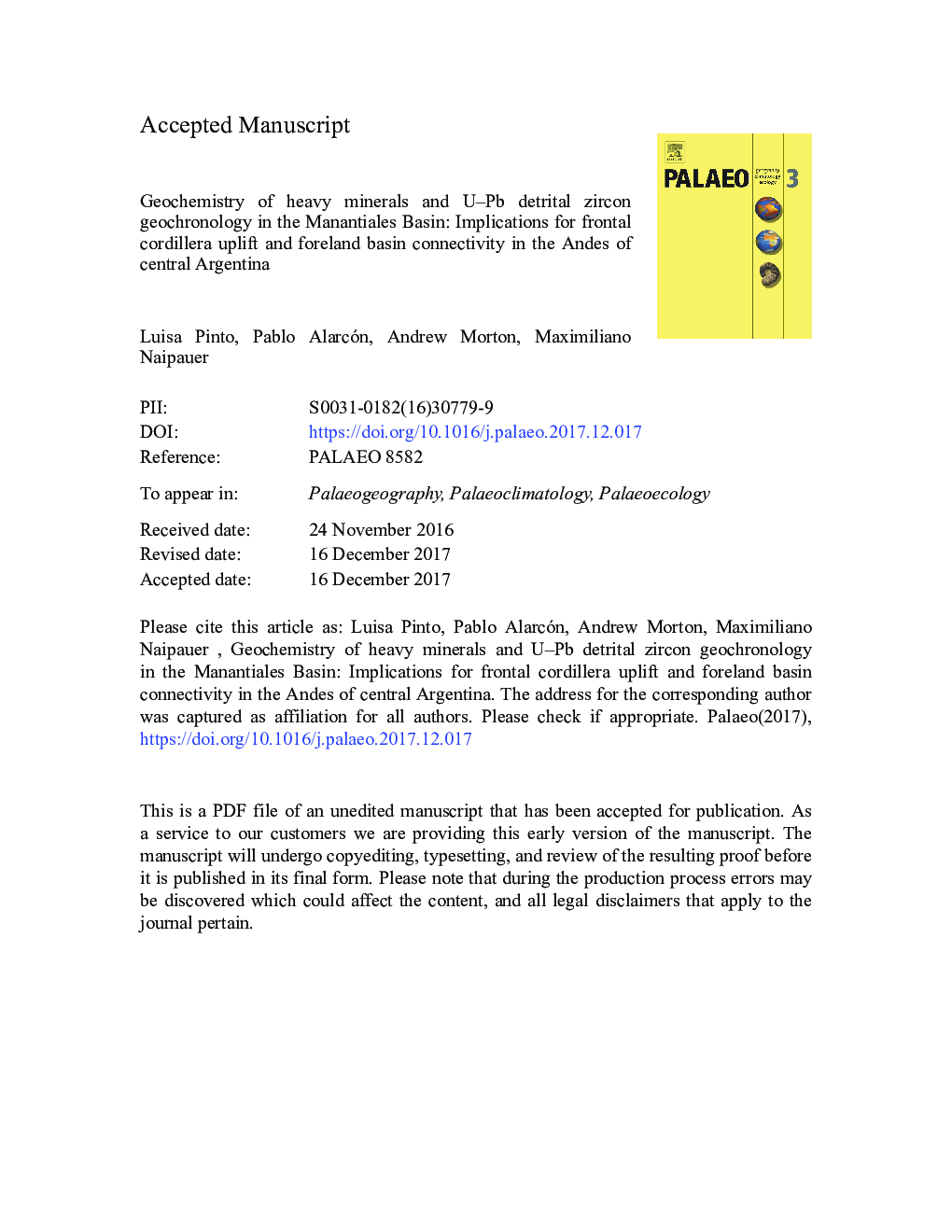| کد مقاله | کد نشریه | سال انتشار | مقاله انگلیسی | نسخه تمام متن |
|---|---|---|---|---|
| 8868398 | 1622100 | 2018 | 84 صفحه PDF | دانلود رایگان |
عنوان انگلیسی مقاله ISI
Geochemistry of heavy minerals and U-Pb detrital zircon geochronology in the Manantiales Basin: Implications for Frontal Cordillera uplift and foreland basin connectivity in the Andes of central Argentina
دانلود مقاله + سفارش ترجمه
دانلود مقاله ISI انگلیسی
رایگان برای ایرانیان
موضوعات مرتبط
مهندسی و علوم پایه
علوم زمین و سیارات
فرآیندهای سطح زمین
پیش نمایش صفحه اول مقاله

چکیده انگلیسی
The Manantiales Foreland Basin, located at ~ 32°15â²S in the Frontal Cordillera, Argentina, contains the sedimentary record of erosion of igneous basement and Miocene volcanic rocks exhumed during the Andean orogeny. U-Pb ages of detrital zircons from the basin fill succession (Chinches Formation) constrain the onset of deposition to ca. 22 Ma (early Miocene). We present the first geochronological control (ca. 22 Ma) from the lower part of the Manantiales Foreland Basin (Areniscas Chocolate member) on the basis of U-Pb ages of detrital zircons, shedding light about an older initiation of this foreland basin. The main heavy mineral association in the sedimentary basin, clinopyroxene + amphibole, indicates two events of volcanic supply, probably corresponding to the Farellones Formation in the Principal Cordillera, and the La Ramada Volcanic Complex and subvolcanic rocks similar to the La Laguna body in the Argentinean Frontal Cordillera. Detrital zircon geochronology indicates dominant sourcing from upper Paleozoic-lower Triassic Choiyoi Magmatic Province rocks. Initial sediment supply at ca. 22-19 Ma was from the Cenozoic volcanic arc of the Principal Cordillera. At ca. 19 Ma, exhumation of the Frontal Cordillera was registered by supply from the Choiyoi Magmatic Province, related to tectonic uplift of a western block (La Ramada-El Espinacito ranges) through a thrust of the La Ramada fold-and-thrust belt. At ca. 16 Ma, supply from the Cenozoic volcanic arc recommenced, providing evidence for capture and erosion of the Principal Cordillera, which could be related to thrusting in normal sequence of the La Ramada fold-and-thrust belt. At ca. 10 Ma, the La Ramada Volcanic Complex and rocks similar to the La Laguna subvolcanic body became a local source of sediment for the basin. The Manantiales Foreland Basin was linked to Neogene sedimentary basins in the Precordillera at its first part in its history, between ca. 22 and 19 Ma and probably until ca. 12 Ma, when the eastern Frontal Cordillera (Cordillera del Tigre) and Precordillera were uplifted, and the foreland basin was broken. Thus, the Frontal Cordillera was uplifted through two diachronous thick-skinned blocks from west (La Ramada-El Espinacito ranges) to east (Cordillera del Tigre). This result can explain the diverse ages for uplift deduced for the Frontal Cordillera in previous studies, where it has been considered rather as a singular N-S block. The source of late Mesoproterozoic detrital zircons registered in the Manantiales Basin is uncertain, but we infer recycling from Mesozoic sedimentary rocks of the Principal Cordillera.
ناشر
Database: Elsevier - ScienceDirect (ساینس دایرکت)
Journal: Palaeogeography, Palaeoclimatology, Palaeoecology - Volume 492, 1 March 2018, Pages 104-125
Journal: Palaeogeography, Palaeoclimatology, Palaeoecology - Volume 492, 1 March 2018, Pages 104-125
نویسندگان
Luisa Pinto, Pablo Alarcón, Andrew Morton, Maximiliano Naipauer,